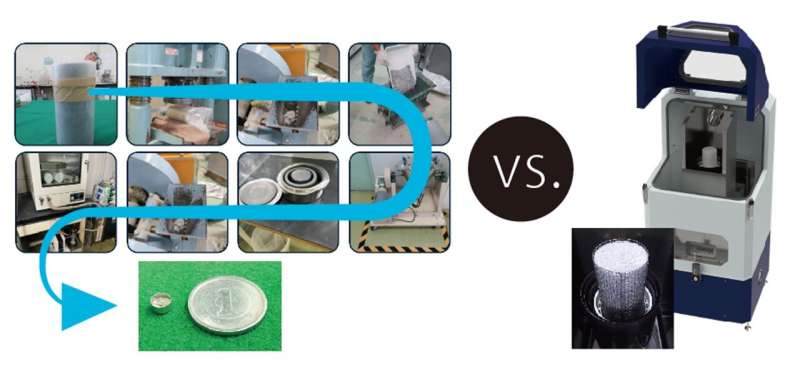This article has been reviewed according to Science X's editorial process and policies. Editors have highlighted the following attributes while ensuring the content's credibility:
fact-checked
trusted source
proofread
New device measures greenhouse gas captured in building material quickly and easily

A new device can measure carbon dioxide captured in concrete more simply and in a third of the time of current methods. Researchers at the University of Tokyo worked with engineers in industry to create the boxlike device called the "concrete thermal gravimetry and gas analyzer."
The device heats concrete samples to almost 1,000°C, causing the CO2 within to be released so it can be measured. The work is published in the Journal of Advanced Concrete Technology.
Compared to the current technique, which involves a time-consuming and complicated process of crushing concrete samples into powder for sampling, this new method is simpler, more accurate and user-friendly.
The researchers hope it will contribute to CO2 trading in the future, as the concrete and cement industry work towards offsetting their emissions as part of global targets to manage greenhouse gases.
Concrete is everywhere. We live in it, walk on it, even make movies and write songs about it. Ubiquitous in modern life and even way back in ancient Rome, this sturdy and durable material is a staple for construction projects around the world. But it is a mixed bag.
On the one hand, the process of making concrete and one of its key ingredients, cement, emits a considerable amount of greenhouse gases. It is estimated that 5%–8% of all CO2 emissions from human activities to date are from cement production alone. But on the other hand, concrete can now be used to store CO2, through methods of carbon capture, utilization and storage.
Achieving "net zero," whereby the amount of CO2 taken out of the atmosphere is equal to the amount released, has become a cornerstone of international policies to tackle global warming. But to do this, we need to know what creates greenhouse gases and at what levels, and how much can be removed through different techniques.
Until now, finding out how much CO2 has been successfully captured in concrete was an extensive process. A cylinder block, about 10 centimeters in diameter and 20 cm high, would be crushed in a way that it couldn't react with the air (which would affect the results). Then a complicated and long process would follow to turn it into a fine, uniform powder from which a small sample was taken for chemical analysis
A new device, developed by researchers at the University of Tokyo with engineers in industry, can skip this time-consuming process. "We developed a new machine which can measure how much CO2 is fixed in concrete or cementitious material without having to crush it," said Professor Ippei Maruyama from the Department of Architecture at the University of Tokyo Graduate School of Engineering.
"Until now, there wasn't a simple method to measure the amount of CO2 fixed in concrete, but with this device, we can shorten the time it takes to measure CO2 and increase the accuracy of the measurement."
A specimen block is placed inside the device and then heated to 980°C. As the block heats up, gases including CO2 are released from the block, which can then be measured. This new process takes about one-third of the time of current methods, limiting the time the concrete can react with the air. Results showed that an accurate measurement could be taken even when CO2 was not uniformly distributed within the block.
Researchers at the University of Tokyo envisioned the concept and parts required for the device, while engineers at Rigaku Corp. then developed it. It was then verified by researchers at the University of Tokyo and Taiheiyo Consultants Co., Ltd.
"This device requires a suitably large space and special safety considerations, so for now, there are some limitations to its application," said Maruyama. "However, after further tests, we hope to make this device commercially available, so that it can contribute to sound emissions trading in the concrete sector and support global efforts to reach carbon neutrality."
More information: Ippei Maruyama et al, Development of a Large-scale Thermogravimetry and Gas Analyzer for Determining Carbon in Concrete, Journal of Advanced Concrete Technology (2024). DOI: 10.3151/jact.22.383

















